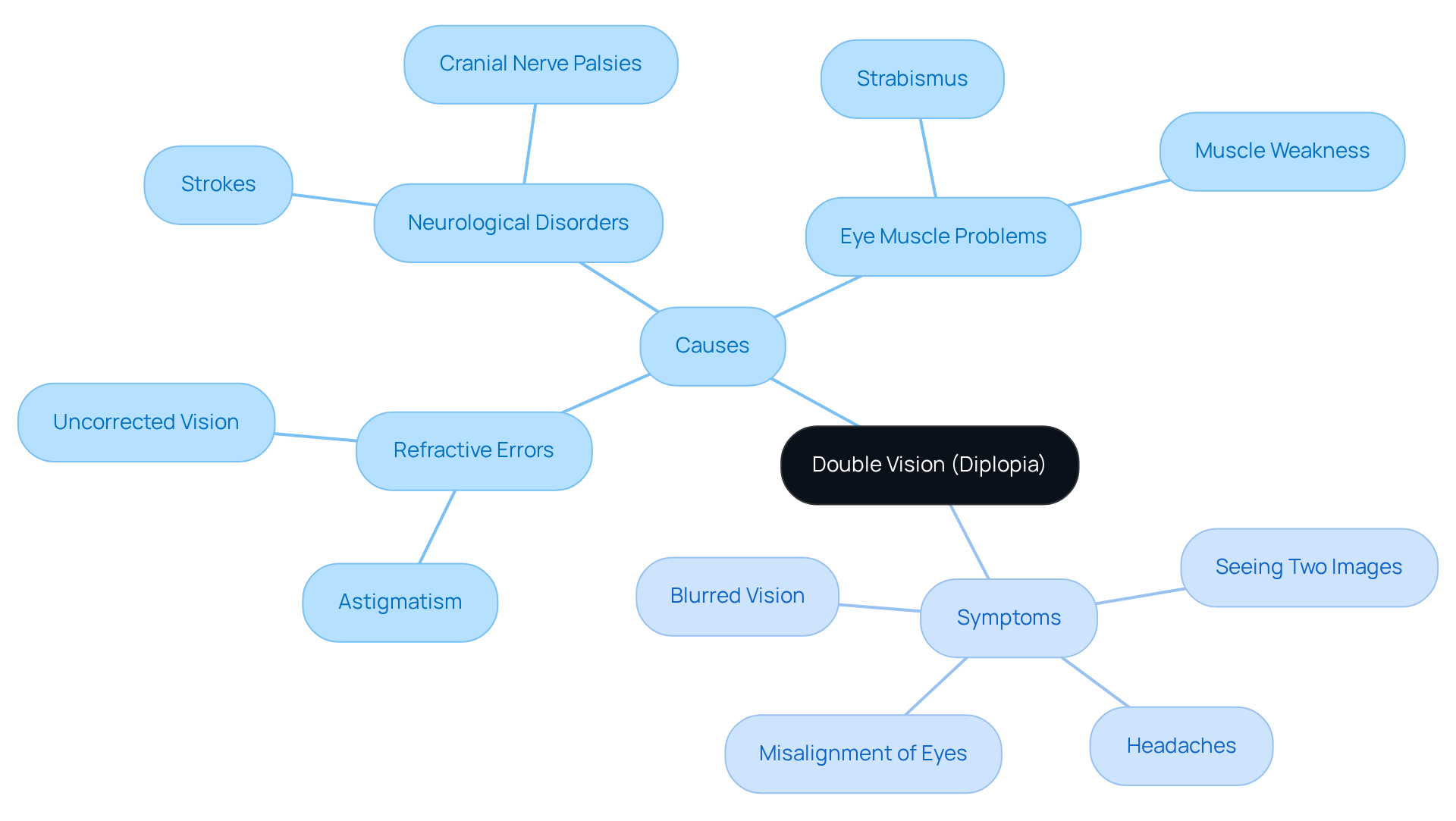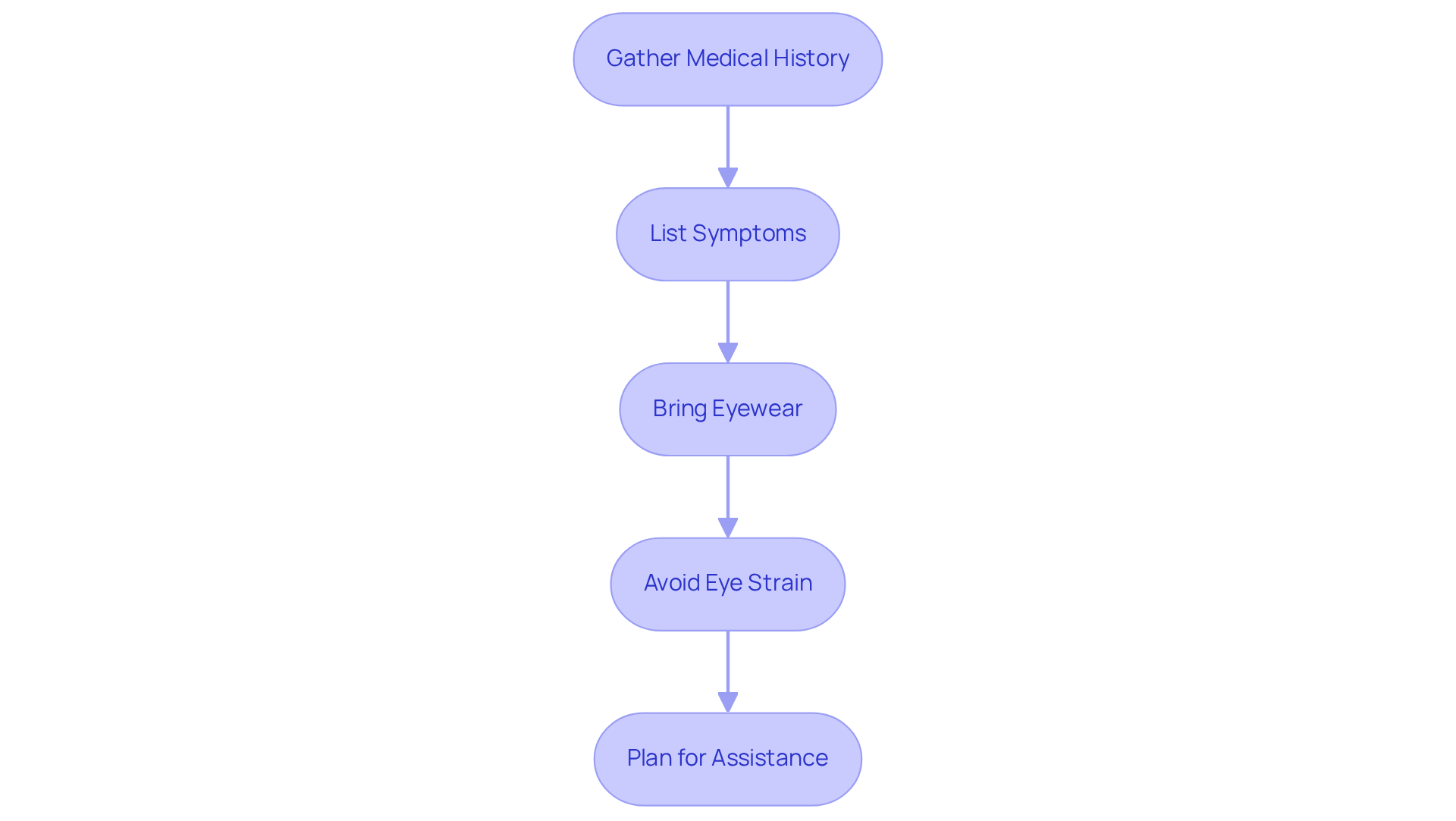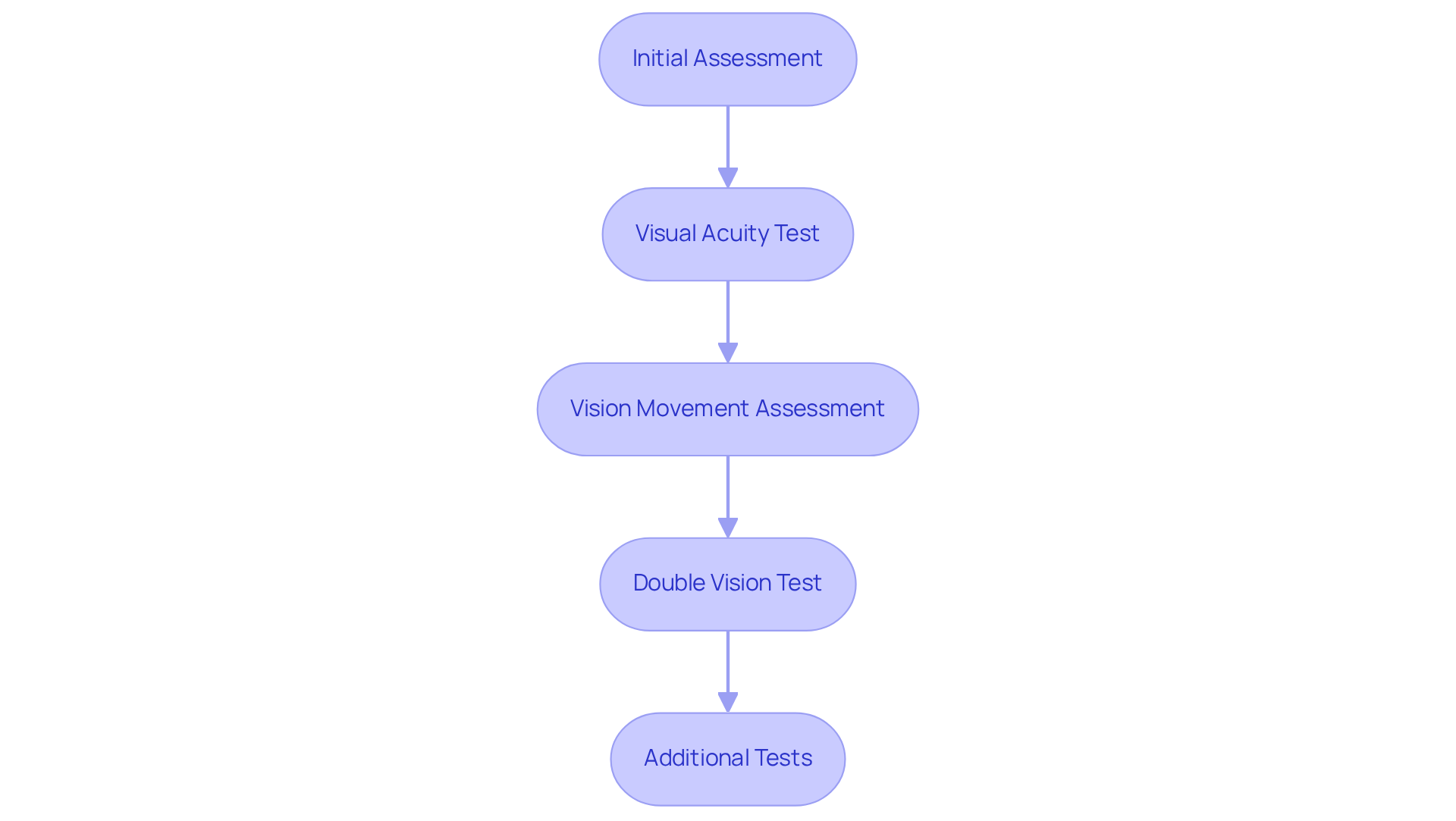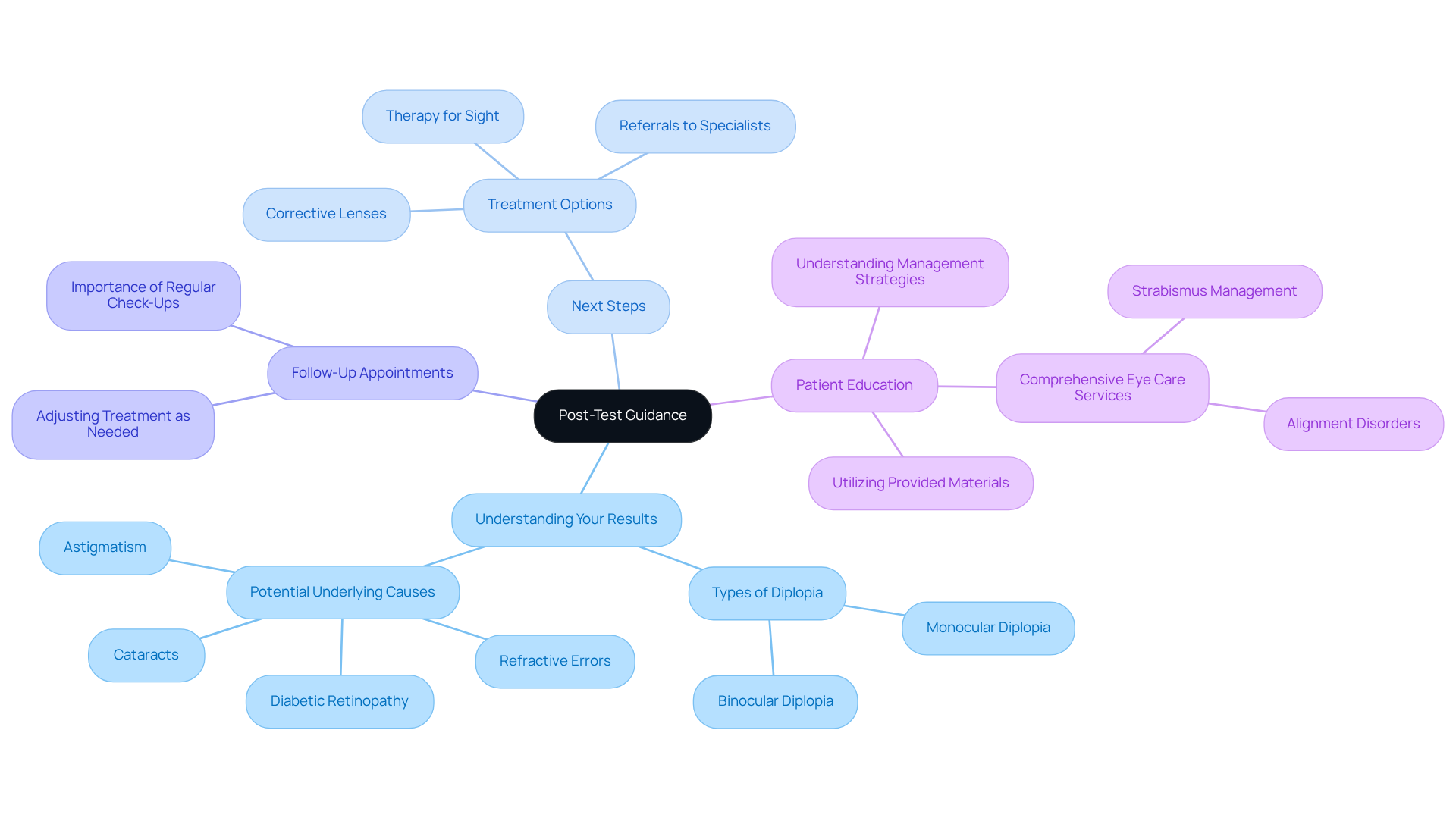Posted by: Northwest Eye in General on November 17, 2025
Introduction
Experiencing double vision, or diplopia, can be a disconcerting symptom that affects countless individuals, especially those over 60. We understand that this can be a challenging experience, and knowing the causes and symptoms of this condition is essential. Diplopia can arise from various issues, ranging from simple refractive errors to more serious neurological disorders.
This article aims to provide you with a comprehensive step-by-step guide to the double vision test process. Our goal is to equip you with the knowledge needed to navigate your symptoms and the testing experience with confidence. But what happens during a double vision test, and how can you prepare to ensure the best possible outcome? We are here to help you through this process.
Understand Double Vision: Causes and Symptoms
Double sight, or diplopia, can manifest in various forms, including monocular (affecting one eye) and binocular (affecting both eyes). We understand that experiencing a double vision test can be concerning, especially since it’s most common in adults over 60, with over 800,000 people visiting healthcare providers annually due to this condition. Common causes include:
- Refractive Errors: Conditions like astigmatism or uncorrected vision can lead to double vision and may also contribute to blurred vision, which refers to a lack of sharpness in vision that can stem from similar abnormalities.
- Neurological Disorders: Issues such as strokes or cranial nerve palsies can disrupt normal eye function, potentially leading to both diplopia and blurred sight.
- Eye Muscle Problems: Strabismus or muscle weakness can cause misalignment, resulting in diplopia.
Symptoms may include:
- Seeing two images of a single object
- Misalignment of the eyes
- Headaches or discomfort when focusing
- Blurred vision, which can signal the presence of eye diseases such as cataracts or diabetic retinopathy.
Recognizing these symptoms early is crucial. We know that timely medical intervention can significantly improve treatment outcomes. Management for diplopia often begins with a double vision test, as it relies on the condition’s origin; for example, individuals facing diplopia resulting from muscle imbalances may benefit from therapy or corrective lenses, whereas those with neurological origins may need more thorough medical assessment.
It’s common to feel anxious about your symptoms, but certain instances of diplopia clear up naturally. However, it’s essential to seek urgent assistance if a double vision test reveals that double sight continues for multiple hours or is coupled with symptoms like eye discomfort, vertigo, muscle weakness, slurred speech, or disorientation. As Tega Egwabor noted, ‘Double sight, medically known as diplopia, affects millions of individuals and while it can arise from simple eye strain, a double vision test is sometimes necessary to determine if this visual disturbance indicates serious underlying brain conditions that require prompt medical attention.’
Comprehending the underlying causes, including unclear sight, and seeking timely care can lead to effective management and resolution of this visual disturbance. Remember, we are here to help you through this process.

Prepare for Your Test: Essential Steps to Follow
To effectively prepare for your double vision test, we understand that following these crucial steps can make a difference:
-
Gather Medical History: Start by compiling a comprehensive record of any prior eye conditions, surgeries, or treatments you’ve undergone. This information is vital for your eye care provider to understand your background and tailor the examination accordingly.
-
List Symptoms: It’s helpful to document specific instances of when double vision occurs during the double vision test, including its duration and any associated symptoms like headaches or dizziness. This detailed account will assist your healthcare provider in diagnosing the issue more accurately. Remember, unclear sight can also signal various ocular issues, such as cataracts, diabetic retinopathy, dry eyes, and macular degeneration, which may require further assessment by a Northwest Eye expert.
-
Bring Eyewear: If you wear glasses or contact lenses, please ensure you bring them to your appointment. This will help the eye care specialist evaluate your sight more effectively.
-
Avoid Eye Strain: To minimize eye fatigue, try to limit screen time and reading in the hours leading up to your test. This practice can help ensure your eyes are in optimal condition for evaluation.
-
Plan for Assistance: If your double vision is severe, consider arranging for someone to accompany you to the double vision test. This precaution is essential for your safety and comfort during the visit.
Recognizing the significance of recording your medical history is vital, as it greatly influences eye treatment utilization statistics. By preparing thoroughly for your appointment, you enhance your overall eye health and ensure that you receive the best possible treatment from Northwest Eye. We are here to help you through this process.

What to Expect During Your Double Vision Test
We understand that you may have concerns and questions during your double vision test. Here’s what you can expect:
-
Initial Assessment: Your eye care specialist will begin by reviewing your medical history and discussing your symptoms. This step is crucial, as undergoing a double vision test can sometimes indicate serious conditions like strokes or cranial nerve issues. We want to ensure you feel heard and understood during this process.
-
Visual Acuity Test: You’ll be asked to read letters from an eye chart. This helps assess your overall vision and identify any impairments. Eye care professionals emphasize that conducting a double vision test is essential for effectively diagnosing diplopia. It’s common to feel a bit anxious, but this test is a standard part of the process.
-
Vision Movement Assessment: Your physician will guide you to track a moving object with your eyes. This checks for proper muscle function and alignment. Understanding eye movement is key to diagnosing conditions that affect cranial nerves, which can lead to binocular diplopia. We know this might feel overwhelming, but it’s an important step.
-
The doctor will conduct a double vision test to assess your vision. The double vision test involves covering one eye at a time to determine if the vision issue is monocular (involving one eye) or binocular (involving both eyes). This distinction is vital for identifying the underlying cause of your symptoms. Remember, you’re not alone in this; many people have similar experiences.
-
Additional Tests: Based on the initial findings, your specialist may suggest further evaluations, such as imaging studies or neurological assessments. These double vision tests help explore the underlying causes of your condition. For instance, MRI scans can rule out serious conditions like tumors or inflammation along a nerve. It’s perfectly normal to feel a bit anxious about these tests, but they are designed to provide clarity and reassurance.
Integrating these steps into your understanding of the double vision test procedure can help you appreciate the thoroughness of the assessment. We are here to help you through this process and encourage you to address any sight problems promptly. Your vision matters, and seeking care is a positive step towards clarity and comfort.

Post-Test Guidance: Interpreting Results and Next Steps
We understand that you may have questions and concerns about the results following your double vision test. Here’s what to expect:
-
Understanding Your Results: You might find out whether your diplopia is monocular or binocular. We’ll discuss potential underlying causes, such as astigmatism or other refractive errors that can lead to blurred vision. Conditions like cataracts and diabetic retinopathy may also come up, as they can contribute to blurriness.
-
Next Steps: Depending on your diagnosis, treatment options could include corrective lenses, therapy for sight, or referrals to specialists for further evaluation. It’s common to feel anxious about unclear sight, but addressing these signs is crucial, as they can indicate issues that need prompt attention.
-
Follow-Up Appointments: We encourage you to arrange any necessary follow-up visits to assess your condition and adjust treatment as needed. Regular check-ups are vital for managing eye alignment disorders and ensuring your vision health remains optimal.
-
Patient Education: We invite you to utilize the materials provided by your eye health provider to deepen your understanding of your situation and management strategies. At Northwest Eye, we are dedicated to offering comprehensive eye care services tailored to address various conditions, including strabismus and other alignment disorders, ensuring you receive the best possible care. Remember, we are here to help you through this process.

Conclusion
Experiencing double vision, or diplopia, can be unsettling. We understand that navigating this condition may feel overwhelming, but knowing the double vision test process can empower you to manage your vision concerns effectively. This guide has illuminated the steps involved, from recognizing symptoms and preparing for the test to understanding what to expect during the assessment and interpreting the results. By approaching this process with knowledge and preparation, you can take proactive steps toward addressing your vision issues.
Key points to remember include:
- The importance of recognizing the various causes of double vision, such as refractive errors, neurological disorders, and eye muscle issues.
- Preparing for the test is crucial; documenting your medical history and symptoms ensures a comprehensive evaluation.
- During the test, a series of assessments will help identify whether the diplopia is monocular or binocular, guiding the appropriate next steps for treatment and management.
Ultimately, seeking timely care and being informed about the double vision test process can lead to improved outcomes and clarity in vision. If you’re experiencing symptoms of diplopia, don’t hesitate to consult with eye care professionals. Early intervention can make a significant difference. Remember, understanding and addressing vision issues is a vital step toward maintaining your overall eye health and well-being. We are here to help you through this process.
Frequently Asked Questions
What is double vision and what are its types?
Double vision, also known as diplopia, can manifest in two forms: monocular (affecting one eye) and binocular (affecting both eyes).
Who is most commonly affected by double vision?
Double vision is most common in adults over 60, with over 800,000 people visiting healthcare providers annually due to this condition.
What are the common causes of double vision?
Common causes include refractive errors (like astigmatism), neurological disorders (such as strokes or cranial nerve palsies), and eye muscle problems (like strabismus or muscle weakness).
What symptoms are associated with double vision?
Symptoms may include seeing two images of a single object, misalignment of the eyes, headaches or discomfort when focusing, and blurred vision.
Why is it important to recognize the symptoms of double vision early?
Recognizing symptoms early is crucial because timely medical intervention can significantly improve treatment outcomes.
How is double vision typically managed?
Management often begins with a double vision test, which helps determine the condition’s origin. Treatments may include therapy or corrective lenses for muscle imbalances, while neurological issues may require a more thorough medical assessment.
When should someone seek urgent assistance for double vision?
Urgent assistance should be sought if double vision persists for multiple hours or is accompanied by symptoms like eye discomfort, vertigo, muscle weakness, slurred speech, or disorientation.
Can double vision resolve on its own?
Yes, certain instances of diplopia can clear up naturally, but it is important to monitor symptoms and seek medical advice if they persist.






